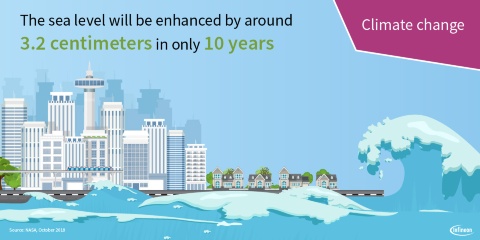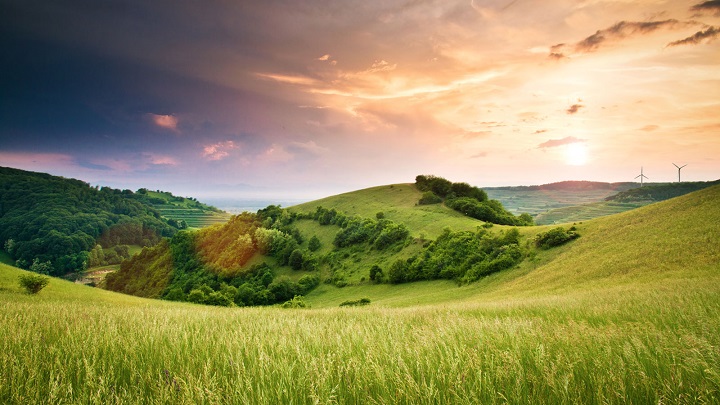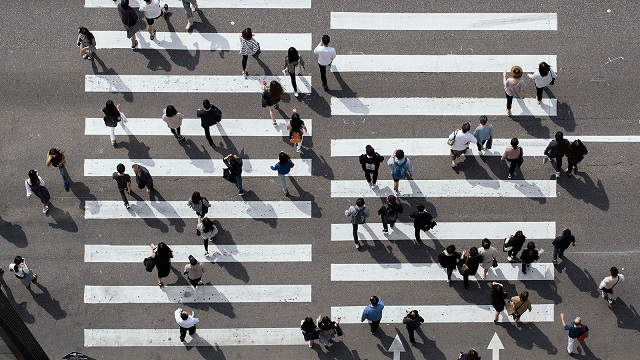
Sinking cities, gigantic deserts, incalculable financial risks:
Scientists paint a gloomy picture of the future when it comes to climate change. It is regarded as one of the biggest challenges facing society.
If we don’t have a radical rethink and adopt a more sustainable and responsible approach toward the Earth and its natural resources, things will get tight for many of us at some time or other – and not just in terms of space. It’s an issue that science, policymakers and business have grappled with for decades. Apart from the commonly known ice age, increasing global warming means the Earth is also threatened by a hot age – in the space of just a few generations. Yet the phenomenon is not only the consequence of human (mis)conduct, but also a natural process.

Climate change? But naturally.
Climate change describes a cooling and warming on Earth over various periods of time, irrespective of whether that is caused by natural influences or us human beings.
Factors in natural climate change
The good news first: We humans aren’t to blame for everything. There are natural factors and processes that have impacted the climate in different ways since long before the dawn of mankind. Some of these influences reinforce each other, while others neutralize each other. One of the main factors in natural climate change is the sun. Its rays are reflected back from the Earth’s surface toward space. However, they often don’t reach it and are instead reflected back to Earth before that by natural gases in the atmosphere, such as methane or carbon dioxide. The upshot is that the planet warms up by what’s known as the greenhouse effect.
That is reinforced by the Earth’s plate tectonics. The shift in the continental plates, combined with associated processes such as the formation of fold mountains, results in a change in the concentration of greenhouse gases. That impacts the reflection of the sun’s rays back to Earth and so the climate. Volcanoes likewise contribute to climate change: An eruption affects the distribution of the gases in the atmosphere. The moon with its influence on the tides, and the oceans with their changing temperatures are other factors that impact the climate.
Global warming – the price of industrialization
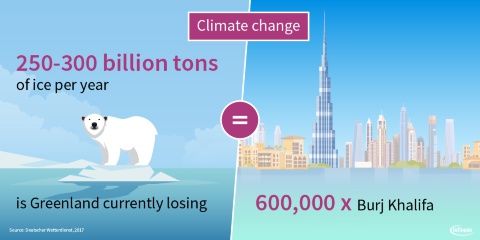
Global warming is a trend that has been substantially influenced by humans. Since the Industrial Revolution in the 19th century, we have reinforced the planet’s natural greenhouse effect through the growing amounts of greenhouse gases we emit. That’s an alarming development: Warming has increased at almost twice the rate per decade over the past 50 years as the trend for the past 100 years. Never before in the 66-million-year history of the Earth have the warming phases been so fast and the jumps in temperature so great. When you consider that also includes warming after the ice age, the dramatic trend is all the more conspicuous. Human influences mean the speed of warming in the future will be around 100 times greater than with natural climate change.
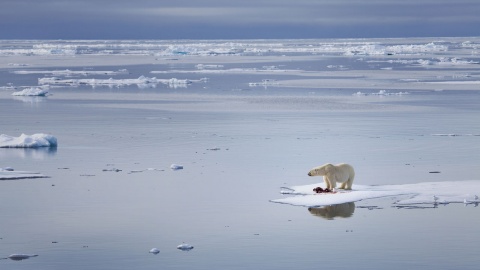
Hot times
The next ice age will shift due to the change in the temperature level. The heat waves that left large parts of Europe sweltering in the summer of 2018 are a preview of how the climate might develop. Experts warn of a hot age – or to use the technical term “hothouse Earth.” According to climate scientists, two degrees of warming are enough to heat our planet by an extra four to five degrees in the long term. It’s a feedback process with devastating consequences: Sea levels will increase by 10 to 60 meters in this scenario. Cities like New York, London or Bangkok would then simply disappear. China, India and Bangladesh would mutate into deserts, while Europe would suffer under permanent drought.
Effects on trees and the quality of wood
There’s also seemingly good news at first sight. Trees grow faster due to climate change. The bad news: The quality of their wood becomes inferior as a result of climate change. Interestingly enough, the samples taken to examine this natural resource date back to the Industrial Revolution. A clear trend is emerging. Although the change in the climate has sped up the growth of trees by 29 to 100 percent since 1900, their wood has become eight to twelve percent lighter at the same time: The trees lack substance. Scientists cite one of the reasons for the reduction in wood density as being climate change. Higher nitrogen levels, caused by agriculture, greater traffic and increasing industrialization, are another contributory factor. The wood is lighter and lighter, less stable and has a lower calorific value. In nature, trees with a lower wood density are more prone to weather influences, such as snow or wind.
The Oktoberfest unaffordable?
“If it gets warmer, a cool beer is the remedy” – but that’s a mistake. Climate change not only entails far-reaching changes on a large scale – the consequences on the smaller scale should not be underestimated, either. One example: The average price of beer worldwide could double as a result of climate change. Why? Due to the hot spells and related periods of drought, we can assume that the volume of barley harvested will drop significantly. A shortage of this raw material would result in higher prices. Researchers from the Intergovernmental Panel on Climate Change forecast in a study that the average barley harvest worldwide will fall by three to 17 percent moving ahead. This whimsical beer anecdote has a serious background: The losses in yield would not stop at barley, but also affect other raw materials. A total of two degrees of global warming would mean agriculture in Central Europe would suffer severe harvest losses. In particular, the corn, wheat and rice harvests in Asia, Africa and America would be hit.
Climate change burns a hole in our pocket: The German Institute for Economic Research (DIW) estimates that climate change could cause economic costs of 200 trillion US dollars by 2050. A study commissioned by the British government assumes damage on the scale of five to 20 percent of global economic output by the year 2100.
Scarcity is growing
A further important factor in the complex that is climate change is the Earth’s natural resources and the fact that they are not infinite. That goes for non-renewable resources such as fossil fuels or mineral resources, or renewable ones like water, wood, plants and animals. The reason: Renewable raw materials are often used faster than they can grow again. In 2018, the renewable resources calculated as theoretically being available for the calendar year were already used up by the beginning of August. In 2000, this Earth Overshoot Day was in September and in 1970 it was in December. That proves that more and more people are consuming available resources faster and faster.

The last chance for humanity?
In the meantime, many in politics, business and society agree that only a radical change of course in climate protection can halt this trend that threatens all of us, while others see little need for action. Yet a radical rethink is necessary, together with the determination and awareness that we need to stop plundering the Earth in favor of a sustainable, climate-friendly way of life. In its special report in 2018, the Intergovernmental Panel on Climate Change declared that global warming can still be limited to 1.5 degrees. The nations that participated in the Paris Climate Change Conference in 2015 had agreed on that limit. A climate protection agreement in which the countries bindingly undertook under international law to limit global warming to a maximum of two degrees came into force in November 2016. In regard to that and after the Federal Constitutional Court ruling from April 2021, Germany has committed itself to achieving its climate targets five years earlier in 2045. By then, the country plans to be climate neutral.
In order to achieve that target, the Intergovernmental Panel on Climate Change believes that radical changes are required in power generation, mobility, agriculture, industrial processes and urban infrastructure.
Last update: July 2021

